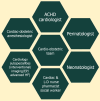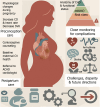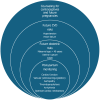Navigating women with congenital heart disease during pregnancy: Management strategies and future directions
- PMID: 40575426
- PMCID: PMC12186142
- DOI: 10.4330/wjc.v17.i6.106295
Navigating women with congenital heart disease during pregnancy: Management strategies and future directions
Abstract
Women with adult congenital heart disease (CHD) face unique challenges during pregnancy, as gestational cardiovascular (CV) and hemodynamic changes can exacerbate underlying cardiac conditions. While these adaptations are well tolerated in women with structurally and functionally normal hearts, they pose significant risks for those with adult CHD (ACHD), whether repaired, palliated, or with residual defects. Maternal CHD is associated with an increased risk of adverse CV events, including stroke, heart failure, arrhythmias, and thromboembolic complications during pregnancy and the peripartum period. Effective management requires a multidisciplinary team, including cardiologists, perinatologists, anesthesiologists, and other skilled care providers. Risk stratification tools such as the modified World Health Organization classification, CARPREG II, and ZAHARA scores are useful for predicting maternal and fetal outcomes and guiding clinical decision-making. Preconception counseling plays a critical role in assessing individual risks, optimizing cardiac function, and educating patients about potential complications. Future research should prioritize innovative therapies, including targeted pharmacological agents and minimally invasive interventions, alongside improved screening methods to identify high-risk patients before symptomatic disease manifests. This review synthesizes current literature on managing pregnant women with ACHD, highlights gaps in clinical practice, and explores future directions to enhance care. Addressing these challenges is essential to improving maternal and fetal outcomes and ensuring comprehensive, patient-centered care throughout the reproductive journey.
Keywords: Congenital heart disease; Contraception; Maternal & fetal outcomes; Postpartum care; Pregnancy; Women with congenital heart disease.
©The Author(s) 2025. Published by Baishideng Publishing Group Inc. All rights reserved.
Conflict of interest statement
Conflict-of-interest statement: There is no conflict of interest associated with any of the senior author or other coauthors contributed their efforts in this manuscript.
Figures






Similar articles
-
Iodine supplementation for women during the preconception, pregnancy and postpartum period.Cochrane Database Syst Rev. 2017 Mar 5;3(3):CD011761. doi: 10.1002/14651858.CD011761.pub2. Cochrane Database Syst Rev. 2017. PMID: 28260263 Free PMC article.
-
Perceptions and experiences of the prevention, detection, and management of postpartum haemorrhage: a qualitative evidence synthesis.Cochrane Database Syst Rev. 2023 Nov 27;11(11):CD013795. doi: 10.1002/14651858.CD013795.pub2. Cochrane Database Syst Rev. 2023. PMID: 38009552 Free PMC article.
-
Metformin for women who are overweight or obese during pregnancy for improving maternal and infant outcomes.Cochrane Database Syst Rev. 2018 Jul 24;7(7):CD010564. doi: 10.1002/14651858.CD010564.pub2. Cochrane Database Syst Rev. 2018. PMID: 30039871 Free PMC article.
-
NIH consensus development conference draft statement on vaginal birth after cesarean: new insights.NIH Consens State Sci Statements. 2010 Mar 10;27(3):1-42. NIH Consens State Sci Statements. 2010. PMID: 20228855
-
Exploring engagement patterns within a mobile health intervention for women at risk of gestational diabetes.Womens Health (Lond). 2025 Jan-Dec;21:17455057251327510. doi: 10.1177/17455057251327510. Epub 2025 Jun 5. Womens Health (Lond). 2025. PMID: 40470610 Free PMC article. Clinical Trial.
References
-
- Stout KK, Daniels CJ, Aboulhosn JA, Bozkurt B, Broberg CS, Colman JM, Crumb SR, Dearani JA, Fuller S, Gurvitz M, Khairy P, Landzberg MJ, Saidi A, Valente AM, Van Hare GF. 2018 AHA/ACC Guideline for the Management of Adults With Congenital Heart Disease: Executive Summary: A Report of the American College of Cardiology/American Heart Association Task Force on Clinical Practice Guidelines. Circulation. 2019;139:e637–e697. - PubMed
-
- Lammers AE, Diller GP, Lober R, Möllers M, Schmidt R, Radke RM, De-Torres-Alba F, Kaleschke G, Marschall U, Bauer UM, Gerß J, Enders D, Baumgartner H. Maternal and neonatal complications in women with congenital heart disease: a nationwide analysis. Eur Heart J. 2021;42:4252–4260. - PubMed
-
- Mehta LS, Warnes CA, Bradley E, Burton T, Economy K, Mehran R, Safdar B, Sharma G, Wood M, Valente AM, Volgman AS American Heart Association Council on Clinical Cardiology; Council on Arteriosclerosis, Thrombosis and Vascular Biology; Council on Cardiovascular and Stroke Nursing; and Stroke Council. Cardiovascular Considerations in Caring for Pregnant Patients: A Scientific Statement From the American Heart Association. Circulation. 2020;141:e884–e903. - PubMed
-
- Canobbio MM, Warnes CA, Aboulhosn J, Connolly HM, Khanna A, Koos BJ, Mital S, Rose C, Silversides C, Stout K American Heart Association Council on Cardiovascular and Stroke Nursing; Council on Clinical Cardiology; Council on Cardiovascular Disease in the Young; Council on Functional Genomics and Translational Biology; and Council on Quality of Care and Outcomes Research. Management of Pregnancy in Patients With Complex Congenital Heart Disease: A Scientific Statement for Healthcare Professionals From the American Heart Association. Circulation. 2017;135:e50–e87. - PubMed
Publication types
LinkOut - more resources
Full Text Sources

